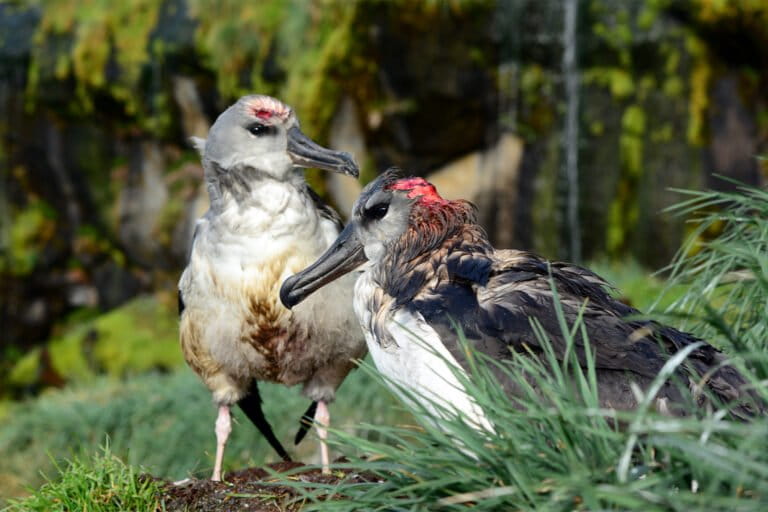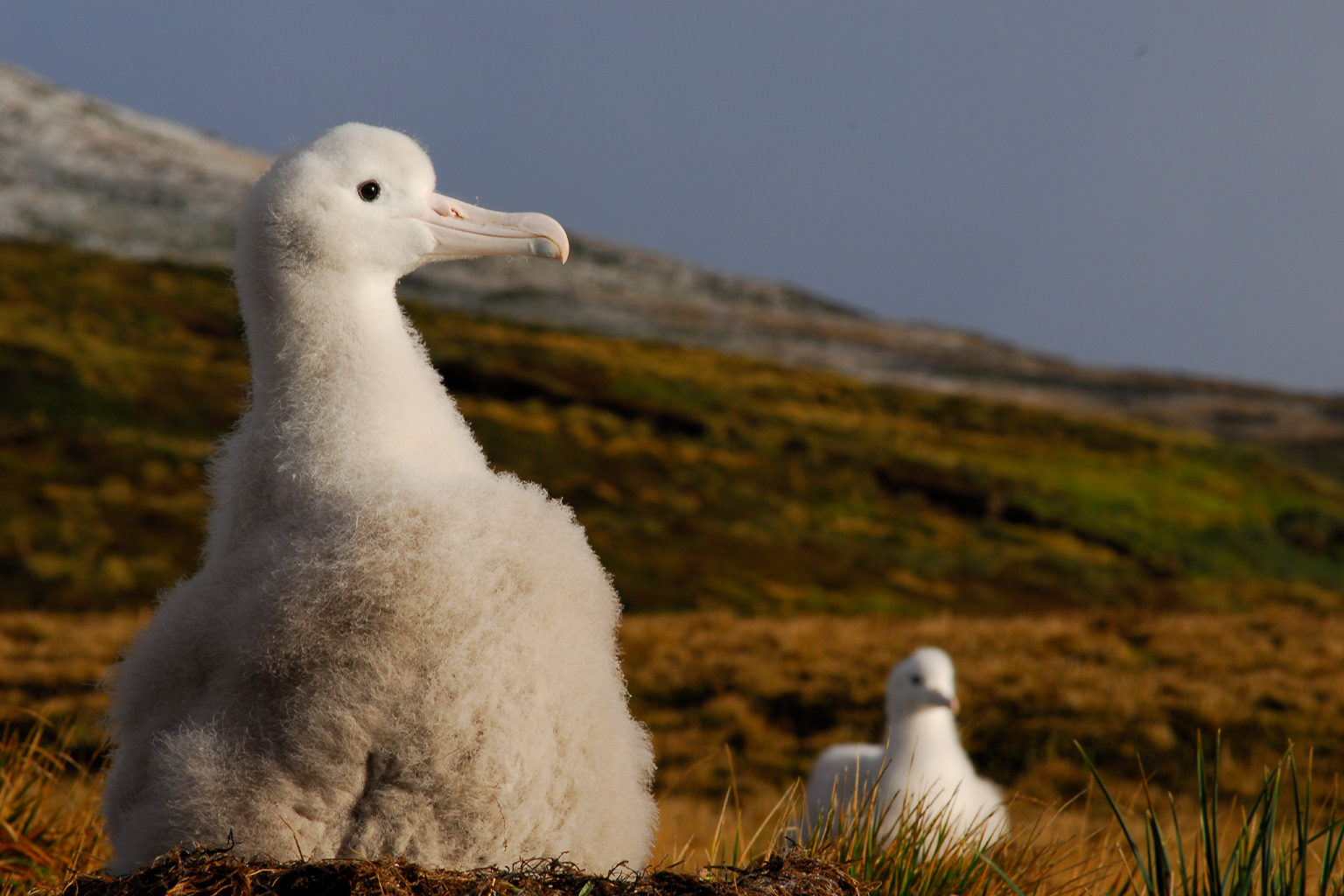- Non-native house mice arrived on Marion Island in the southern Indian Ocean two centuries ago, when the island was a stopping-off point for sealing ships.
- Their population has exploded recently, as temperatures warm and summers lengthen. With more mouths to feed, they’ve gutted their main food source — insects — and are now feeding on seabird chicks and adults.
- While mouse attacks on seabirds remain low and their impact on nesting or breeding success isn’t known yet, conservationists nevertheless see them as a serious and growing threat.
- Now the South African government is planning a rodent eradication program for mid-2025 that will be the largest of its kind on a sub-Antarctic island.
CAPE TOWN — Evidence of mice attacking albatross chicks on Marion Island, midway between South Africa and Antarctica, makes for grim viewing. One video, captured at a colony of endangered gray-headed albatrosses (Thalassarche chrysostoma) in 2015, shows the first mice emerging shortly after sunset. Chicks stand defensively in their nests through the night, but once fatigue sets in, they settle down. The mice quickly scurry onto their heads, and tear in.
One chick gives in, tucking its bill under a wing and enduring the hours-long assault, before eventually shaking off its attacker.
The video, filmed remotely by Ben Dilley, at the time a doctoral researcher at the Percy FitzPatrick Institute of African Ornithology at the University of Cape Town, confirmed an alarming pattern. When mice come upon younger, down-covered chicks, they first attack the birds’ wings or rumps. With older fledglings, whose feathers have toughened, the mice find easier pickings on the chicks’ heads, where the soft crown feathers still give quick access to the skin. Over the course of hours, a single mouse can gnaw the chick’s entire crown away, down to the bone.

By dawn, Dilley’s video showed the wounded chicks alive but weakened with pain and exhaustion. Scalped, wings drooping, the chicks were less likely to clap their beaks defensively at an approaching threat. They were easy prey to predators such as petrels, and likely to contract potentially lethal secondary infections.
This year conservationists also recorded the first fatal mouse attacks on adult birds, after finding eight adult wandering albatross (Diomedea exulans) carcasses in April, the freshest of which had clear signs of mouse bites.
This escalation of attacks on birds gives new impetus to an ambitious mouse eradication program scheduled to start in April 2025 and run through the southern hemisphere winter, which aims to rid Marion Island of mice entirely. Conservationists say they hope it will enable the ecosystem to recover, including insects and plants that have borne the impact of mouse activity far longer than the seabirds.
The Mouse-Free Marion (MFM) rodent eradication project, run jointly by South Africa’s Department of Forestry, Fisheries and the Environment and the conservation nonprofit BirdLife South Africa, will be the largest of its kind on a sub-Antarctic island.

Globally important seabird colony
Marion Island is one of two that make up South Africa’s Prince Edward Islands Marine Protected Area, a globally critical seabird nesting site about 2,200 kilometers (1,400 miles) southeast of Cape Town.
The two islands are each home to about one-quarter of the world’s breeding wandering albatrosses. Marion is also an important breeding spot for other seabirds, such as the endangered sooty albatross (Phoebetria fusca), near-threatened light-mantled albatross (Phoebetria palpebrata), burrowing petrel species (order Procellariiformes) and a rare sheathbill subspecies (Chionis minor marionensis) that has largely abandoned its need to fly.
The non-native house mouse (Mus musculus) arrived at Marion two centuries ago, when the island was a stopping-off point for sealing ships during the heyday of blubber hunting. Cats were introduced as pets and to control mice in 1948, but quickly went feral and flourished into their own enormous problem, killing nearly half a million seabirds annually, according to one estimate. An island-wide eradication program started in 1986 and the animals were gone by 1991.
Until recently, the mice have survived mostly on insects and some plant seeds. But their population has exploded in the past three decades, largely because warmer, drier summers linked with rising global temperatures are giving them longer breeding seasons, and possibly because of the eradication of cats. With more mouths to feed, they’re gutting their usual food sources. Researchers have found a sharp drop in invertebrate numbers since the mid-1970s and a significant impact on certain plant species whose seeds and fruiting heads the mice like to eat.
Hungry, they have learned that nesting seabirds are easy targets, and Dilley’s study showed an “unprecedented” increase in the attacks since they were first recorded in 2003. Still, the total number of attacks remains low, and researchers say there isn’t enough research to measure how much mouse predation might be impacting the seabirds’ nesting or breeding success. They nevertheless flag it as a serious threat to Marion’s seabird populations.
Starting in early April 2025, a fleet of helicopters with the MFM project is scheduled to crisscross the island, spreading blood-thinning rodent-targeted bait in a blitz that will aim to wipe out the entire mouse population in one season.
In preparation, MFM plans to spend the next two years gearing up for this “logistically complex operation,” said Anton Wolfaardt, the project manager with BirdLife South Africa.
If successful, Wolfaardt told Mongabay by phone, it will allow the island to bounce back from the accelerating damage caused by mice before any localized extinctions of native species happen.


Wild winter weather
Marion and its rodent-free sister 21 km (13 mi) away, Prince Edward Island, sit squarely in the “Roaring Forties,” a band of ocean between the latitudes of 40° and 50° south that’s legendary for strong westerly winds and turbulent storms. One early visitor here described this band as where the “world’s wildest weather is born.”
In the southern-hemisphere winter of 2022, MFM field assistant Elsa van Ginkel braved these conditions to set up her own remote cameras at strategic sites on Marion, trekking miles over rugged terrain to do so. These she trained on something more ephemeral than the nests that Dilley had previously surveilled: the clouds shrouding the dormant volcanic peaks in the island’s interior.
Her hourly time-lapse photographs will help map cloud cover patterns over the hard-to-access inland peaks. Together with weather data collected through the 2022 winter, these will allow the operations team to plan for unpredictable flying conditions that may vary between the thickly vegetated coast and the highest polar desert region where barely anything grows.
The mice are concentrated around the coastline, where their primary food source is and where the birds nest, but the helicopter pilots will need to spread their bait evenly, including over the cold, harsh interior in case the odd outlier rodent family has settled there. The eradication team has also earmarked some lava tunnels for baiting by hand.
“The biggest challenge will be the weather,” said project operations manager Keith Springer, a New Zealander with two decades of experience from similar projects on sub-Antarctic islands such as Gough, Macquarie and South Georgia.

“We have to bait outside of the summer mouse breeding season,” he told Mongabay in a phone interview. “In winter, it’s harder for them to find food and survive. Their population should be stressed and their numbers down because of the cold and their main food sources — invertebrates — is low.”
Hungry mice will be more likely to take the bait.
A winter operation, which in the Southern Hemisphere means the middle of the year, leaves pilots with fewer daylight hours and shorter windows in which wind and cloud conditions are suited to flying and dropping bait.
South Africa has had a meteorological station and scientific research base here since the country claimed the territory in 1948. It has several decades of weather data, but these are limited to conditions on the island’s somewhat sheltered northeast where the base is located. Van Ginkel’s hourly time-lapse images and daily weather readings will give a better picture of conditions elsewhere on the island.
Every winter is different, but Springer said they already have a rough idea of how many flying hours to plan for: very few.
“We expect to have about five to six operational days per month, and we hope to be there for five months,” he said. “The only way to counter this risk is to be as productive as possible.”
MFM has an advisory group guiding the operation on how to lower the risk that non-target species may be exposed to the bait. Sheathbills and kelp gulls (Larus dominicanus) are most likely to scavenge dead rodents. But the poison is slow-acting, and the mice are expected to return to their burrows before it takes effect, reducing the number of bodies out in the open. A winter operation means that most other bird species will have left the island for the season.

Learning from other islands
A camera trap image taken in December 2021 on Gough Island, 3,900 km (2,400 mi) northwest of Marion, delivered a blow to conservationists: a single mouse appeared in the frame, evidence that the rodent eradication attempted on this U.K.-administered island a few months earlier had failed.
It’s still not clear why; the U.K.’s Royal Society for the Protection of Birds (RSPB) is waiting for the findings of a review that will help it understand what went wrong. The MFM operation hopes to learn from this, and is drawing from the experiences of other similar efforts, including successful eradications at South Georgia, Campbell, Antipodes and Macquarie islands.
In spite of some mice not taking the bait on Gough, the attempt confirms one important thing, according to the RSPB’s head of global policy, Andrew Callender: when mouse predation drops, bird colonies rebound with astonishing speed.
By the end of the 2022 southern summer, Gough’s mouse population was still low, and the bird breeding success that year was “spectacular,” Callender wrote in a February 2023 blog post.
Researchers logged a 75.5% breeding success among Tristan albatrosses (Diomedea dabbenena) that year, compared with the 30.2% annual average since 2001. Gray petrel (Procellaria cinerea) breeding success bounced to 78% from a 30% average in recent summers. MacGillivray’s prions (Pachyptila macgillivrayi), down to 6% breeding success in previous years, recovered to a “phenomenal” 82%, Callender wrote.
Each island has unique features that affect rodent — and eradication — success. South Georgia, for instance, has glaciers that created natural barriers to rodent movement. It also had different target species and densities: mostly rats, with only a few mice on some peninsulas.
Even so, all these sub-Antarctic island rodent eradication efforts face similar challenges and use similar methods, Wolfaardt said.
“These projects show that best practice principles can and do work,” he said. “We’re not trying something new here, it’s a tested approach with a high success rate for a conservation tool.”
Banner image: Wandering albatross on Marion Island. Image by Credit Otto Whitehead.
Stamping out invasive species has successful track record on islands, study finds
Citations:
Huntley, B. J. (2023). Marion Island: Birds, cats, mice and men. In Strategic Opportunism: What Works in Africa: Twelve Fundamentals for Conservation Success (pp. 21-37). Springer Nature Switzerland. doi:10.1007/978-3-031-24880-1_4
Parkes, J. (2014). Eradication of house mice Mus musculus from Marion Island: A review of feasibility, constraints and risks. BirdLife South Africa Occasional Report Series, 1. Retrieved from https://www.birdlife.org.za/media-and-resources/birdlife-south-africa-occasional-reports/
Dilley, B. J., Schoombie, S., Schoombie, J., & Ryan, P. G. (2015). ‘Scalping’ of albatross fledglings by introduced mice spreads rapidly at Marion Island. Antarctic Science, 28(2), 73-80. doi:10.1017/s0954102015000486
FEEDBACK: Use this form to send a message to the editor of this post. If you want to post a public comment, you can do that at the bottom of the page.
